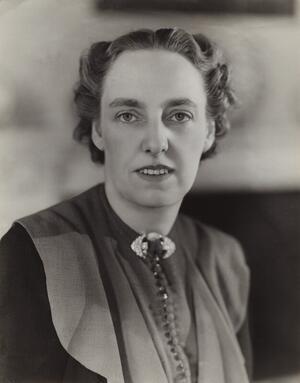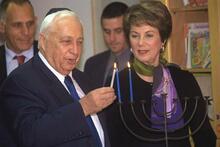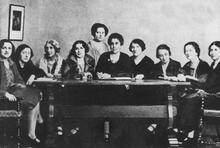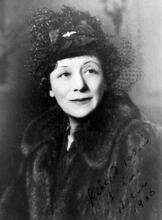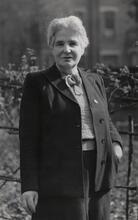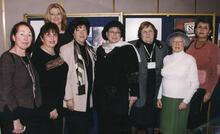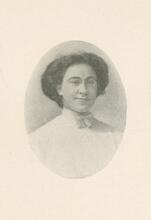Eva Violet Mond Isaacs, Second Marchioness of Reading
Lady Eva Violent Mond Isaacs was born in London in 1895 to a Christian mother and a Jewish father and raised a practicing Christian. After marrying the Jewish, Gerald Isaacs, she was introduced to Zionism and began to gravitate towards Palestine and Judaism. She began studying Hebrew, became involved with childcare organizations in Palestine, and soon converted to Judaism. After the death of her father-in-law, she gained aristocratic status and began receiving higher honors and positions of power within her work. She was Vice President of the World Jewish Congress and the first Jewish president of the National Council of Women and was awarded the CBE for her work in children’s welfare. She is remembered for her devotion to promoting Jewish rights all over the world.
Lady Eva Violet Mond Isaacs, Marchioness of Reading, was born into one remarkable family and married into another. She occupied a unique place in Anglo-Jewry; as Vice President of the World Jewish Congress and President of its British section she was an eloquent and vocal supporter of the Zionist cause and the young state of Israel.
Family and Early Life
Eva’s mother Violet, née Goetz, was a strict Anglican of Huguenot origin; her father Alfred Mond (1868–1930) was Jewish, the son of the German-born chemist Ludwig Mond (1839–1909), who invented the alloy nickel and founded the Brunner Mond Company, which merged into ICI in 1926. The Monds lived in the affluent area of St. John’s Wood in London. Alfred and Violet were married in church in 1892 and moved to Lowndes Square in Chelsea. Violet was musical and artistic, and the house was filled with remarkable works of art, including paintings by Mantegna and Bellini. She organized extraordinary parties; her guests included Princess Helena Victoria, and Sir Thomas Beecham was invited to conduct the music.
Eva was born on August 6, 1895. Her early years were filled with comforts, governesses, and holidays at her grandfather Ludwig Mond’s Palazzo Zuccari, near the Spanish Steps in Rome. Her education followed the traditional lines of a wealthy young girl of her era; in her early years she was taught at home by a governess, before being sent to Miss Wolff’s, in South Audley Street, and then to boarding school at Northlands at Englefield Green. At seventeen she was sent to finishing school in Paris and a year later, in 1913, she was sent for a year to finishing school in Munich.
Marriage to Gerald Isaacs
In August 1912, Eva joined her family on a holiday to Scotland. It was there that she met Gerald Isaacs (1889–1960), the elder son of Sir Rufus Isaacs (1860–1935), then Attorney General in Asquith’s Liberal government. Alfred Mond was also a Liberal, although by 1926 he had broken with the Liberal party in protest at the Land Policy and joined the Conservatives. A close friend of Chaim Weizmann, Mond increasingly focused his political energies on Zionist activities.
Eva and Gerald met again the following year at her family’s temporary home in Palace House, Beaulieu. A church wedding was planned after Eva’s “coming out” in 1914 (she was presented at Court in May), but with the outbreak of war the date of the wedding was brought forward to September 1914. Just before the wedding the Archbishop of Canterbury refused to authorize a Church wedding between Eva, a practicing Christian, and Gerald, a Jew. After a civil ceremony the marriage was blessed in Holy Trinity Church, Sloane Street.
Eva and Gerald’s first shared home was in Berkhamsted, where Gerald was in military service until he was transferred to the War Office in London; in October 1916 he was posted to France. Their son Michael was born in London, where Eva spent much of the war, as their second child, Joan, required specialist treatment there. Their third child, Elizabeth, was born in 1921.
It was Eva’s own experiences as a mother of three, combined with the extreme levels of child poverty she had witnessed when she accompanied her father canvassing in his constituency in Chester and then Swansea, that focused her objectives to improve the conditions of working women and their children. In 1929 Gerald ran (unsuccessfully) for parliament in Blackburn. Though the cotton mills were vast employers of women, Eva was horrified to see that there was no childcare available at all for these workers and that their children’s welfare was suffering greatly as a result. Violet, Eva’s mother, was also involved in child welfare charities, and Eva became increasingly involved in the Sunbabies Home in Hoxton and in other organizations.
Introduction to Zionism
After Gerald’s father Rufus, Lord Reading, became Viceroy of India, Eva and Gerald made two trips there, in 1922 and 1924, leaving the children behind and staying for two months each time. Meanwhile, the involvement of Eva’s father Alfred Mond with Zionism led him to take several trips to Palestine. Eva accompanied him on her first visit in 1928. The journey took them through Egypt, Syria, and Iraq; with her mother she visited many sites of Christian interest along the way and in Palestine. She recalls in her autobiography her intense disappointment when she visited the Church of the Holy Sepulchre: “Looking back I think that it was the beginning of the psychological struggle between my Christian upbringing and my growing Jewish consciousness.” On her return to London she began to study Hebrew with David Kaminsky, a student at the London School of Economics who went on to run her father’s plantation near Tiberias. Although enthusiasm did not make up for lack of aptitude and she never picked up more than the most basic elements of the language, Eva became a committed and active Zionist at around this time.
Eva became Chair of the National Society of Day Nurseries, President of The Association of Nurses’ Training Colleges, and a member of the National Society for Maternity and Child Welfare The plethora of interwar voluntary associations was testament to the relative absence of British state provision, which increased after 1945. She also became involved in the Jerusalem Baby Home and the Tel Aviv Mothercraft Society.
After Alfred Mond’s death in 1930, Eva went to Palestine in 1931 with Chaim and Vera Weizmann to visit the house Alfred had built in Tiberias, Migdal. Her brother Henry (1898–1949) also came out on his first visit to Palestine then, and became passionate about the country. Eva was amazed to discover in September 1933 that Henry had converted to Judaism without telling her. She too was going through the conversion process; both siblings were determined not to influence the other with their decision and thus neither had confided in the other. Soon afterwards Eva converted with the rabbi of the Liberal Jewish Synagogue in St. John’s Wood. Of her three children, only her elder daughter Joan followed her mother by converting to Judaism.
Zionist Work
Eva began to visit Migdal every spring, always inviting guests to join her, including George Bernard Shaw (about whose visit she had few positive remarks to make), Orde Wingate, Chaim Arlosoroff, and David Ben-Gurion. After the establishment of the state, when she was in residence, she flew the Union Jack and the Israeli flag over the villa, which during World War II was at various times taken over by the Palmah and by the British Army.
With the death of Gerald’s father Lord Reading in 1935, the couple became the Second Marquis and Marchioness of Reading. Her new-found aristocratic status did not prevent Eva from continuing to balance both her Zionist commitments and her involvement in child welfare. In 1937 Eva and Henry went to the Twentieth Zionist Congress in Zurich. Henry became Chairman of the Jewish Agency and Eva Chair of the British section. She also became involved in Helen Bentwich’s Children’s Refugee Movement, which brought children from Germany to the United Kingdom in the years leading up to World War II. In 1942 she was invited to become advisor to Ernest Brown, then Minister of Health, on daycare issues. In 1945 Queen Mary invited her to become Chair of the Needlework Guild and in 1947 she became Vice President of the World Jewish Congress. She joined the National Council of Women and in 1957, when she became President, thought herself the first Jewish woman to do so; in fact, Constance Flower, née Rothschild, Lady Battersea, had been President from 1902 to 1904 (when the NCW was called the National Union of Women Workers), and Henrietta Franklin was President from 1925 to 1927. The previous year she was awarded the CBE for her work in children’s welfare.
Her brother’s early death in 1949 at the age of fifty-one deprived her of her closest Zionist partner, since her husband Gerald had never shared her passion for Palestine/Israel, although he did occasionally accompany her on her visits there before his sudden death in 1960 whilst they were on holiday in Rhodes.
In 1971, two years before her death, she was awarded an honorary fellowship at the Hebrew University of Jerusalem. At the ceremony it was said that “throughout her lifetime she has devoted herself wholeheartedly to the promotion of Jewish rights all over the world—to the attainment of the Jewish people’s vision—the reconstruction of its ancient homeland in sovereign independence. … Her services to the Jewish people have been a central expression of her devotion to human rights and human dignity throughout the world and particularly to the rights of women.” Eva, Dowager Marchioness of Reading, died on August 14, 1973.
Selected Work
For the Record: The Memoirs of Eva, Marchioness of Reading. London: Hutchinson, 1973.

